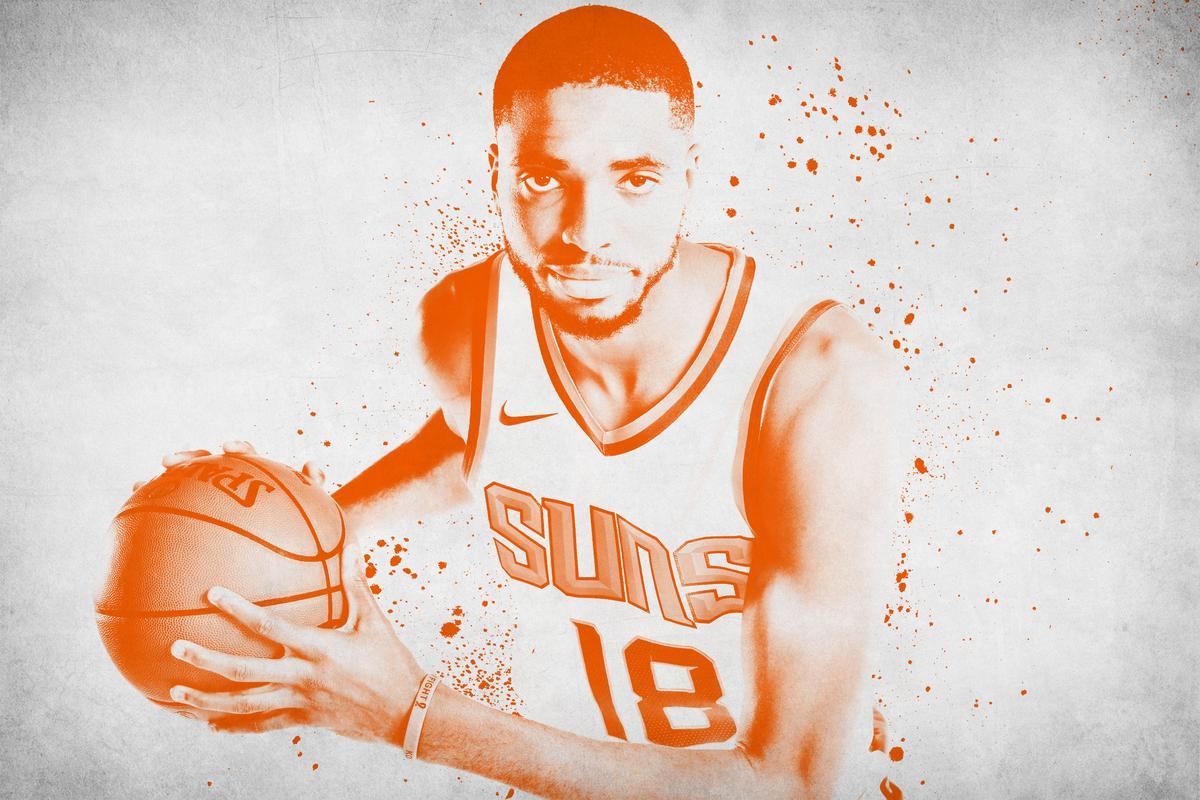
The summer is a time to dream big with newly drafted rookies. But paths to stardom in the NBA are never linear, and every rookie has a unique set of roadblocks to overcome before he can capitalize on his potential. Over the next few weeks, Jonathan Tjarks will be examining some of the 2018 draft’s top talents and how the reality of their team’s situation will affect their freshman season. Welcome to the Rookie Curve.
The Suns went all in on Mikal Bridges, trading an unprotected first-round pick in 2021 from the Heat to the 76ers in order to move up six spots in the draft and acquire the no. 10 overall selection. The future pick was a valuable asset to give up for a player who doesn’t have an obvious path to playing time as a rookie. Phoenix had one of the more unsettled rosters in the NBA even before it traded Brandon Knight and Marquese Chriss to Houston for Ryan Anderson and De’Anthony Melton last week. Bridges can contribute right away, but he’s more of a future play for the Suns. He’s the perfect long-term piece on the perimeter next to Devin Booker.
Bridges is a safe pick with little chance of being a bust, a stark contrast to the dice rolls on the two raw big men (Chriss and Dragan Bender) the franchise acquired in 2016. The 22-year-old is the latest product of Jay Wright’s NBA factory at Villanova. He got better every season of college, going from a sixth man as a freshman to third-team All-American as a junior, and won two national titles in the process. Wright turned Villanova into the most successful program in college basketball by embracing an NBA-influenced style of play. He doesn’t recruit one-and-dones like Duke and Kentucky, but his players shoot 3s, move the ball, and defend multiple positions. Bridges was one of four Wildcats taken in the first 33 picks in this year’s draft.
Bridges combines elite 3-point shooting (43.5 percent on 6.0 attempts per game in his junior season; 40 percent across his entire college career) with elite length for his position (6-foot-7 and 210 pounds with a 7-foot-1 wingspan). It’s an unusual combination. He’s one of only eight major-conference players in NCAA history to have a season in which he shot more than 40 percent from 3 on more than three attempts per game while also averaging at least one block and 1.5 steals. All eight of the guys on that list went on to play in the NBA, most notably Kevin Durant, Shane Battier, Danny Green, and current Suns vice president of basketball operations James Jones. (Paul George, Danny Granger, and Robert Covington were among those who reached those marks in smaller conferences.)
The knock on Bridges is his lack of shot-creating ability. He averaged 17.7 points a game on 51.4 percent shooting last season, but most of his offense came from spotting up and moving without the ball. Bridges is a fairly rudimentary ball handler, and he doesn’t have an elite first step. He depended on Jalen Brunson, the Naismith Award winner, and Donte DiVincenzo, the hero of the NCAA championship game, to collapse the defense and kick the ball out to him.
That didn’t happen in summer league, which is why he averaged only 6.2 points a game on 45.5 percent shooting in five games. The two point guards on the roster (Shaq Harrison and Élie Okobo) were more score-first players than Brunson, a gifted passer who often got Bridges going early in games. It was hard to see what Bridges could do well in Las Vegas. He needs a more structured role in an offense where he can play off more talented players.
Defenses can’t leave Bridges open. He doesn’t need much space to get his shot off. He has a quick release, and he’s so much longer than most perimeter defenders that he can just shoot over them. And while he didn’t score much in Las Vegas, his outside shot translated to the longer NBA 3-point line. He shot 7-of-16 from 3 (43.8 percent), and he was in the 99th percentile of spot-up shooters among summer league players, per the tracking numbers at Synergy Sports. Bridges isn’t a one-dimensional shooter, either. He’s a smart player who can attack a closeout, get into the lane, and find the open man.
His offensive ceiling is a guy who shoots 3s off movement, like J.J. Redick or Kyle Korver. The best shooters in the NBA don’t just stand in place. They get open by constantly moving, which Bridges did in college. He was in the 93rd percentile of scorers nationwide on cuts and in the 91st percentile when coming off screens away from the ball. A shooter who is deadly on the move can score without holding the ball. Even when he doesn’t score, he creates opportunities for his teammates because defenses have to keep track of him. Bridges creates value on offense with a low usage rate, which is important for a Suns team that has invested heavily in three high-usage young players: Booker, Josh Jackson, and Deandre Ayton.
Where Bridges separates himself from most high-level shooters is his defense. Unlike Redick or Korver, Bridges figures to be a defender who can more than hold his own. The Celtics brutalized Redick in their second-round series against the 76ers, and they played Kyle Korver off the floor in the Eastern Conference finals against the Cavs. Bridges is versatile enough to be an effective contributor on that side of the ball, regardless of opponent. He defended point guards at Villanova at the top of their 1-2-2 full-court press, and he switched between players at all five positions. He doesn’t have elite speed or strength, but his length, tenacity, and defensive IQ should allow him to stay in front of smaller players.
It’s unclear what his role will be this coming season because the Suns may not be done making moves. Four-fifths of their projected starting lineup appears locked in: Booker, Anderson, Ayton, and Trevor Ariza, whom they signed to a one-year, $15 million contract in the offseason. However, they don’t have an experienced point guard on the roster after trading Knight, and it’s hard to see them going into the season with two rookies (Okobo and Melton) and a second-year player (Harrison) at the position. Phoenix has the assets to make another trade. If the team did end up starting one of its younger point guards, that would leave T.J. Warren, who averaged 19.6 points a game on 49.8 percent shooting last season, coming off the bench, as well as Tyson Chandler and three recent lottery picks in Jackson, Bridges, and Bender.
One twist that new Suns head coach Igor Kokoskov could try is to play Booker at point. Phoenix’s star wing is more of a natural scorer, but the team has experimented with putting him on the ball. He wasn’t great in the role last season, averaging 4.7 assists per game on 3.6 turnovers last season for an underwhelming assist-to-turnover ratio of 1.31-1. Nevertheless, he does have potential, especially when running pick-and-rolls. Booker was in the 61st percentile of scorers on the play leaguewide last season, and he’s such a good off-the-dribble shooter that defenses often swarm him. He needs more shooters who can create space for him: The Suns were dead last in the NBA in 3-point percentage (33.4 percent) last season.
Booker and Bridges should work well together. Playing with Bridges would allow Booker, who has been a terrible defender since coming into the league, to hide on the least threatening backcourt player on a nightly basis. On offense, Bridges would space the floor for Booker, and his low-usage style would allow Booker to dominate the ball. They could also set screens for each other off the ball in the same way Steph Curry and Klay Thompson do in Golden State. Having two elite shooters constantly moving around the court puts tremendous pressure on a defense, and Jackson and Ayton are skilled enough to play with the ball and hit them in stride.
The goal should be for Booker and Bridges to eventually take as many 3s per game as Curry and Thompson (16.9). They almost certainly won’t be as effective as two of the greatest shooters in NBA history, but just taking that many 3s can be valuable, as long as they maintain a baseline of efficiency. The average number of 3s that NBA teams attempt per game has risen ever since the 3-point line was introduced in the 1979-80 season, but the rate has spiked over the past five years, going from 20.0 per game in 2012-13 to 29.0 per game in 2017-18. No one knows when it will slow down. By the time Bridges is coming off his rookie contract, having multiple volume 3-point shooters in the starting lineup might be a necessity rather than a luxury.
There are a lot of moving parts on the Suns’ roster at the moment, but their long-term core is in place. They signed Booker to a five-year, $158 million contract in the offseason, and used top-four picks on Jackson and Ayton in the past two drafts. Bridges, at 22, is the oldest of the four, and he’s the only 3-and-D player in the group. Booker and Ayton have significant defensive questions, and Jackson is an inconsistent shooter. They need two-way players like Bridges around them to be effective. He’s the glue that makes the rest of their young core fit together. The Suns paid a heavy price to acquire Bridges, but it might have been worth it.

